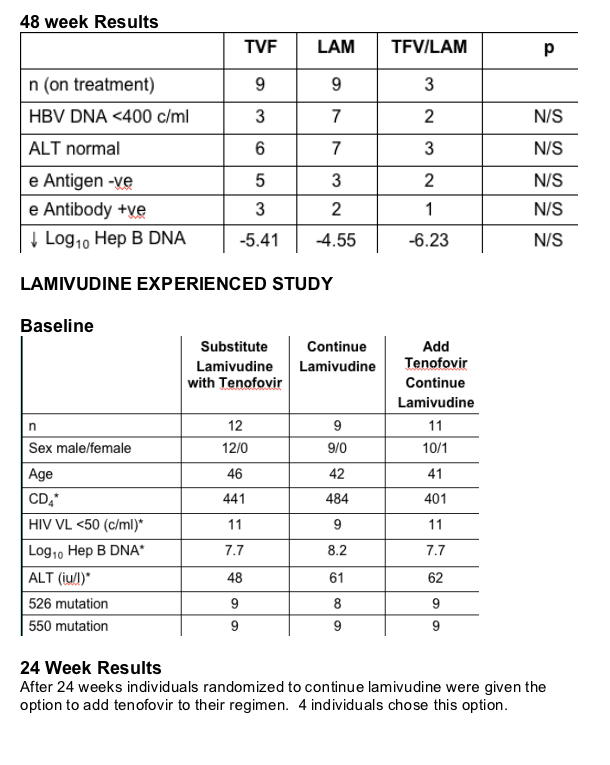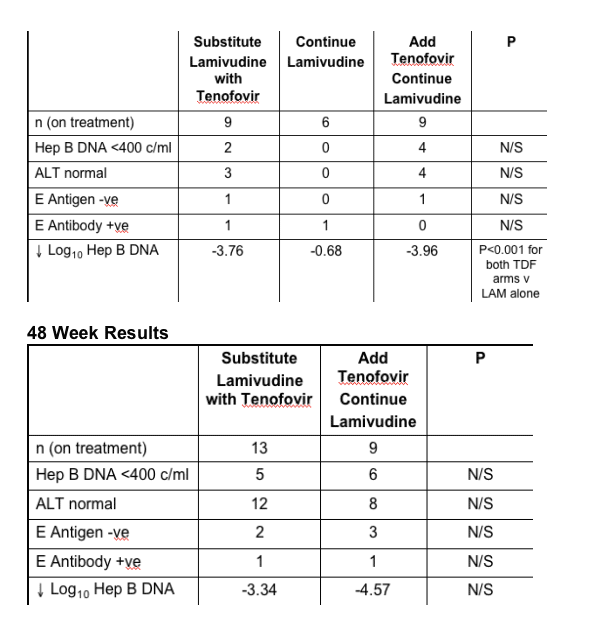 |
 |
 |
| |
Tenofovir + Lamivudine (3TC) for HBV/HIV Coinfection
|
| |
| |
"A 48 week study of tenofovir (TDF) or lamivudine (LAM) or a combination of tenofovir and lamivudine for the treatment of chronic hepatitis B in HIV/hepatitis B co-infected individuals"
Nelson M1, Bhagani S2, Fisher M3, Leen C4, Brook G5, Mandalia S1, Reilly G6, Pillay D7, Mathews G1;
1Chelsea and Westminster Hospital , London. 2Royal Free Hospital, London. 3Royal Sussex County Hospital , Brighton. 4Western General Hospital, Edinburgh. 5Central Middlesex Hospital , London. 6Gilead Sciences, Cambridge. 7University College London.
AUTHOR CONCLUSIONS
- At the 24 week end-point, in HBV treatment naive patients, combination therapy with TDF and LAM, and therapy with TDF alone showed significantly higher viral load reduction than the LAM alone, whilst combination therapy showed a trend towards a higher viral load reduction although this was not statistically significant
- In naive patients, week 48 viral load reduction was equivalent in patients receiving LAM and TDF compared to TDF alone
- There were no new YMDD mutations observed in the treatment naive patients at the 24 and 48 week time-points
- In LAM experienced patients, there was no benefit in continuing LAM alone; adding or switching to TDF resulted in a significantly better viral load reduction at the 24 week time-point
- This is the first randomised controlled study to support current recommendations for using combination therapy in lamivudine naive subjects.
- LAM experienced patients with continued HBV replication should switch to TDF or add TDF depending on LAM activity against HIV
Co-infection with HIV and HBV is common. 70-90 % of HIV infected patients have markers of previous HBV infection and HBsAg carriage after acute infection is increased from 10% to 20-25%1. Patients who are HBsAg positive / HIV antibody positive have been shown to have higher levels of HBV replication and lower transaminase levels than comparable HIV negative patients2. Long-term complications of chronic hepatitis B infection include the development of cirrhosis and hepatocellular carcinoma (HCC). As HIV-related morbidity and mortality continue to fall with the widespread use of HAART, the occurrence of serious HBV-related liver disease in the HIV positive population is likely to rise.
Lamivudine (3TC, is a potent inhibitor of both HIV and HBV and was approved by the FDA for use in chronic HBV infection in1998. Lamivudine is already commonly prescribed as an antiretroviral agent in the treatment of HIV (although at a higher dose of 150mg bd or 300mg od), and can be used as part of a HAART regimen for patients with dual infection. A retrospective analysis of HBV infected patients within the CAESAR study (lamivudine +/- loviride added to zidovudine) demonstrated a significant reduction in HBV DNA levels during 52 weeks in those patients on lamivudine (40% HBV DNA <400 copies/ml) and an HBeAg loss of 20%3.
The elevated HBV DNA levels in HIV infected patients may potentially lead to a higher incidence of HBV resistant virus. This is well recognised to occur in immuno competent patients. Mutations associated with lamivudine are more rapidly selected in patients with HBV/HIV co-infection with an incidence rate of 50% and 90%, after 2 and 4 years, respectively4,5,6.
Resistant virus emerges through the development of mutations within the highly conserved YMDD motif around the catalytic site of reverse transcriptase, analogous to the M184V mutation in lamivudine-resistant HIV. Patients with these mutations continue to show partial suppression of HBV DNA levels and there is evidence that improvement in transaminases and histological changes may continue to occur although seroconversion becomes less likely.
Having learnt the lessons of nucleoside monotherapy in HIV disease there is increasing interest in the use of dual agents in the HBV/HIV setting.
Tenofovir is a nucleotide analogue with activity against hepatitis B (currently unlicensed for Hep therapy) and HIV and as such has significant potential for use in the treatment of HIV/hepatitis B co-infected individuals. It has demonstrated activity in both lamivudine naive7 and lamivudine experienced patients8. A retrospective analysis has demonstrated superior activity of tenofovir combined with lamivudine when compared to lamivudine alone in treatment naive HIV/HBV co-infected individuals7. Questions still remain, however, about the potency and value of combination therapy with tenofovir and lamivudine in treatment naive patients, and the value of continuing lamivudine in failing patients.
This study was designed to investigate rates of HBV suppression and hepatitis B seroconversion in patients receiving lamivudine or tenofovir alone, or a combination of both these drugs.
METHODS
HIV infected individuals with actively replicating Hepatitis B and who were e antigen positive were eligible for study inclusion.
Individuals were randomized to a naive study for those who had never received hepatitis B therapy and to an experienced study for those who had virologically failed lamivudine therapy.
Naive study
HIV positive individuals who were lamivudine naive and who were hepatitis B positive with evidence of HBV replication were randomised to receive therapy for 24 weeks with:
1. Lamivudine 150mg bd or
2. Tenofovir 300mg daily or
3. Lamivudine 150mg bd and tenofovir 300 mg daily
After 24 weeks all patients on lamivudine monotherapy in group 1 added tenofovir to their regimen. Patients in groups 2 and 3 continued to 48 weeks on their randomised therapies.
Individuals who were already receiving a HAART regimen either substituted or added the above drugs to their current regimen depending on physician and patient choice.
Experienced study
HIV positive individuals who were lamivudine experienced and who were hepatitis B positive with evidence of HBV replication were randomised to:
1. Continue on lamivudine alone
2. Substitute lamivudine with tenofovir 300mg daily or
3. Continue on lamivudine and add tenofovir 300mg daily to their regimen
Individuals who were not currently receiving lamivudine but had received it in the past with evidence of virological failure and may therefore have developed 3TC-resistant HBV, recommenced lamivudine. If after a period of 3 months they continued to have active HBV replication they were randomised to the study. After 24 weeks patients on lamivudine monotherapy in group 1 could add tenofovir to their regimen. Patients in groups 2 and 3 continued to 48 weeks on their randomised therapies.
Primary endpoint
24 week time-weighted change in Log10 HBV DNA from baseline (DAVG24).
Secondary endpoint
Proportion of patients with HBV DNA < 400 copies/ml at 24 and 48 weeks
Proportion of patients HBeAg negative at 48 weeks
Normalisation of ALT at 48 weeks
RESULTS
59 of 78 planned subjects had been randomised prior to changes in the British HIV Association co-infection guidelines [2005]; 27 were LAM naive and 32 LAM experienced. The change in the guidelines recommending that no patient should receive LAM monotherapy for hepatitis B resulted in the termination of further study recruitment.



References
1. Gatanaga et al. Eur J Clin Microbiol Infect Dis 1997; 19: 237-9
2. Gilson R et al. AIDS 1997; 11: 597-606
3. Dore G et al. J Infect Dis 1999; 180: 607-613
4. Dore G et al. J Infect Dis 1999; 180: 607-13
5. Hoff J et al. Clin Infect Dis 2001; 32 : 463-9
6. Benhamou Y et al. Hepatology 1999; 30 : 1303-06
7. Dore G et al. J Infect Dis 2004; 189 : 1195-92
8. Benhamou Y et al. N Eng J Med 2003; 348 : 177-178
|
|
| |
| |
|
 |
 |
|
|